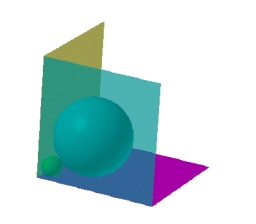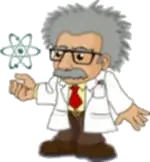Tangent spheres
A sphere with a radius of 1 m is placed in the corner of the room. What is the largest sphere size that fits into the corner behind it?
Additional info: Two spheres are placed in the corner of a room. The spheres are each tangent to the walls and floor and tangent to each other.
Additional info: Two spheres are placed in the corner of a room. The spheres are each tangent to the walls and floor and tangent to each other.
Final Answer:

Tips for related online calculators
You need to know the following knowledge to solve this word math problem:
solid geometryplanimetricsbasic operations and conceptsGrade of the word problem
Related math problems and questions:
- Billiard balls
 A layer of ivory billiard balls radius of 6.35 cm is in the form of a square. The balls are arranged so that each ball is tangent to everyone adjacent to it. In the spaces between sets of 4 adjacent balls, other balls rest, equal in size to the original.
A layer of ivory billiard balls radius of 6.35 cm is in the form of a square. The balls are arranged so that each ball is tangent to everyone adjacent to it. In the spaces between sets of 4 adjacent balls, other balls rest, equal in size to the original. - Spheres in sphere
 How many spheres with a radius of 15 cm can fit into the larger sphere with a radius of 150 cm?
How many spheres with a radius of 15 cm can fit into the larger sphere with a radius of 150 cm? - On the floor 2
 The living room's floor area is 9 7/9 m². A carpet covering an area of 5 5/8 m² is placed on the floor. Find the area of the room that is not covered with carpet.
The living room's floor area is 9 7/9 m². A carpet covering an area of 5 5/8 m² is placed on the floor. Find the area of the room that is not covered with carpet. - Cannonballs
 Three cannonballs with a diameter of 16 cm landed in the castle courtyard during the battle. The castle blacksmith made balls with a diameter of 10 cm, which fit into the cannons placed on the walls. How many cannonballs did the blacksmith cast?
Three cannonballs with a diameter of 16 cm landed in the castle courtyard during the battle. The castle blacksmith made balls with a diameter of 10 cm, which fit into the cannons placed on the walls. How many cannonballs did the blacksmith cast? - Sphere and cone
 Within the sphere of radius G = 33 cm, inscribe the cone with the largest volume. What is that volume, and what are the dimensions of the cone?
Within the sphere of radius G = 33 cm, inscribe the cone with the largest volume. What is that volume, and what are the dimensions of the cone? - Metal balls
 Four metal balls with a diameter of 5 cm are placed in a measuring cylinder with an inner diameter of 10 cm. What is the smallest water volume to be poured into the cylinder so that all balls are below the water level?
Four metal balls with a diameter of 5 cm are placed in a measuring cylinder with an inner diameter of 10 cm. What is the smallest water volume to be poured into the cylinder so that all balls are below the water level? - Two balls
 Two balls, one 8cm in radius and the other 6cm in radius, are placed in a cylindrical plastic container 10cm in radius. Find the volume of water necessary to cover them.
Two balls, one 8cm in radius and the other 6cm in radius, are placed in a cylindrical plastic container 10cm in radius. Find the volume of water necessary to cover them.
